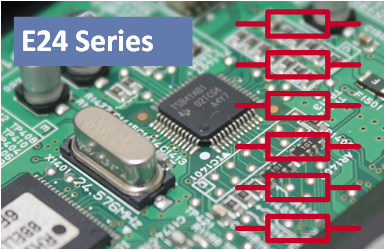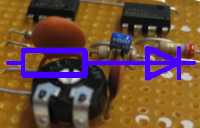Resistor color code reading direction
Manufacturers of resistors sometimes make things a bit easy for themselves. How often have you looked at a resistor
and found no sign where the color code starts and ends? Here you will find 8 rules that help you to read each resistor
color code in the right direction.
Rule 1: The widest band
The direction in which to read a resistor color code is often indicated by a wider band. The wider band is the last one.
If you do not see a wider ring on your resistance, you have to check the following other criteria.
Rule 2: The greater distance
Often one ring has a larger distance to the others. This indicates that this is the last ring in the color code.
But especially for resistors with five or more bands, manufacturers do not manage
to print the tolerance band wider or with a greater distance. Then you have to pay
more attention to the colors to see the correct direction:
Rule 3: Colors that never mark the first ring in the pattern:
Gold, silver and black are never in the first band in the standard color code structure.
So if one of these colors has a band at one edge then you better read from the other side.
If you have an exotically coded resistor in front of you, this rule is not always applicable.
Rule 4: The 0Ω resistor
An exception of rule 3 is the 0 Ω resistor. It consists completely of black bands.
The direction in which you read this color code is of course irrelevant.
Rule 5: Well known color patterns
Those who know the known color patterns often have no trouble reading a resistor correctly.
The common numbers from the E-series, such as 56, 82, 12, 33, have characteristic color patterns
that can be easily memorized with some experience. These color patterns determine the first rings
in the resistor color code.
If you still can't determine from which side you have to read the resistor, things are getting more
complicated. But there are other possibilities:
Rule 6: Colors that never mark the last ring in the pattern:
Depending on the number of rings there are colors that never appear in the last ring. This is how you can recognize the first ring.
Look at the resistor color code table to see this colors for color codes with four, five or six bands.
Rule 7: Colors that never occur in the second last ring:
If everything hasn't helped up to here, you can check if there is a color in the
second last ring, which never occurs there. Depending on the number of rings, this
is the power of ten ring or the tolerance ring. Look in the
resistor color code table
to find out which colors never appear there.
Rule 8: Only the multimeter can help
You have not succeeded with rule 1 - 7? Then I guess only the ohmmeter will help.
Maybe you have to unsolder the resistor from the circuit. Hard work, but unfortunately this sometimes
cannot be avoided. After all, you do not have to remember any colored rings.
X

Picture 1: The widest band shows the tolerance

Picture 1: The widest band shows the tolerance
X

Picture 2: The last band has more distance to the others

Picture 2: The last band has more distance to the others
X

Picture 3: The first band is never gold, silver or black

Picture 3: The first band is never gold, silver or black
X

Picture 4: Exeption: The 0Ω resistor has all bands black

Picture 4: Exeption: The 0Ω resistor has all bands black
X

Picture 5: Recognize the common color patterns of the first two bands.

Picture 5: Recognize the common color patterns of the first two bands.
X

Picture 6: Some colors are never in the last band

Picture 6: Some colors are never in the last band
X

Picture 7: There are colors which are never in the second band

Picture 7: There are colors which are never in the second band





